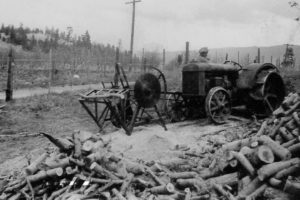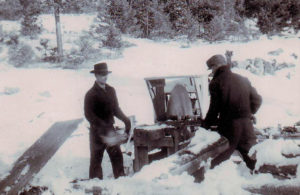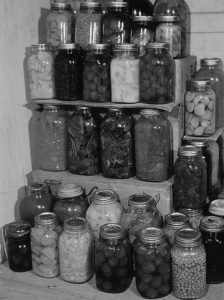As the years and decades go by, there is an inclination to say things like: “Winters just aren’t what they used to be.” Having spent more winters here than most, I entirely agree with that statement. So far this season seems an exception with early frequent snowfalls, and prolonged cold temperatures, more reminiscent of the winters of my youth.
As a small child I recall the winter of 1949-1950 when Okanagan Lake froze over in its entirety. I sat on a scoop shovel while my Dad pulled me around on the ice in front of where we currently live. Later, he and Uncle Cecil skated across the lake. In 1985 our Ice Racing group began racing our cars at Duck Lake on 15 inches of hard ice. That was in late November. Nowadays it sometimes seems that winter has become mostly an inconvenience requiring us to tidy up our gardens, dig out our winter wear and put on the snow tires. In earlier days the approach of winter was taken much more seriously requiring extensive preparation.

Starting in the fall our dad would begin hauling home loads of dry wood. The tractor would be hooked up to a homemade buzz-saw for cutting the wood to stove length, which would then be piled in the woodshed. Like many others our primary source of heat for cooking and comfort came from a wood stove. The coal oil heater was hauled from the garage for installation in our living room and a 45- gallon drum of oil ordered. Plastic sheeting was stapled onto our single paned windows in an attempt to improve heat retention.

A full barrel of oil and a large woodpile assured some level of warmth through the winter. The more fortunate homeowners, with sawdust or coal furnaces, would stock up with fuel. Today, houses have double glazed windows, 2 x 6 construction and they are filled with highly efficient insulation. Our family home like many others was insulated with wood shavings. Considering the wood stoves and all wood construction of the day it is small wonder that many houses burned down. Now we prepare our home for winter by checking the furnace filter and when it was last serviced.

Dad wasn’t the only one thinking ahead. Mom’s job was to ensure an ample larder for winter, with only the necessities coming from the store. This began with the harvest as garden vegetables, fruits and berries were preserved. Vegetables that would keep like carrots and turnips went into cold cellars. Few fresh vegetables and fruit were either available or affordable during a long winter. It was only after the cellar and woodshed were filled that our parents felt prepared for a Canadian winter.
In the ‘50’s our winter clothing carried no labels reading Gore-Tex, Thinsulate or even “waterproof” for that matter. After playing outdoors mom would make us wait on the porch until she’d used a broom to beat most of the ice off that was frozen to our woollen clothing. Our feet always seemed to be both wet and cold. Winter clothing has improved dramatically making time spent outdoors far less unpleasant.
In the ‘50’s our vehicles were driven only by the rear wheels; the extra traction provided by front wheel drive wasn’t an option. Four-wheel drive existed primarily in Jeeps. I recall driving back and forth to Vancouver in British sports cars with no winter tires and about as much traction as a hockey puck on ice. Early winter tires often had ground walnut shells or sawdust added to the compound in an effort to improve traction. Drivers often had chains and actually knew how to use them. Getting stuck was a common occurrence. No calls to BCAA; passing motorists would pull over to help with the necessary digging and pushing. Cold weather invariably resulted in hard starting or no starting in those days before fuel injection and high amp electrical systems. Modern vehicles are available with front or all-wheel drive, ABS braking, traction and stability control, heated seats and steering wheel and four sticky winter tires. For good measure consider how well and quickly our roads are cleared. Before you start to disagree bear in mind that when I was a kid we had one truck to clear all local roads. It usually involved Ernie Pow driving while Henry Redecopp scattered gravel off the back with a shovel. Many of our roads were simply not used if there was a hill involved.
On a less human note winter has even improved for many family pets. In early days our family cats were simply pushed out the door at bedtime to fend for themselves. They were always waiting to be let in come morning. Many dogs either slept on a blanket in a porch or, imagine this, had a little dwelling out back called a dog house. Today not having Fido sleeping anywhere other than on his owner’s bed or a comfortable spot near a heat register might result in a visit from the SPCA.
This column often contrasts life today with earlier times. In many respects it’s not so much better or worse, merely different. When it comes to enduring a Canadian winter it’s no contest…give me the current experience anytime. One thing that never seems to change, however, is our preoccupation with weather and our right to complain about it. Brrrrr! 4
Written by Rich Gibbons, Okanagan Centre
1 Richard Gibbons
2 Richard Gibbons
3 Wikipedia
4 This article appeared previously in The View in Lake Country, January 13, 2017, p. 5.







Sarah Byatt
I was born in September of 1949 and my mother always said I was the only person in our family that was warm that winter!
Carl shearer
Great article
Carl shearer
I really like reading articles like this
Sheron JOHNSON
What memories this brings. Winter was fun for children when we were just kids. No rides to hockey, skating lessons or ski hills.
We made our own fun!